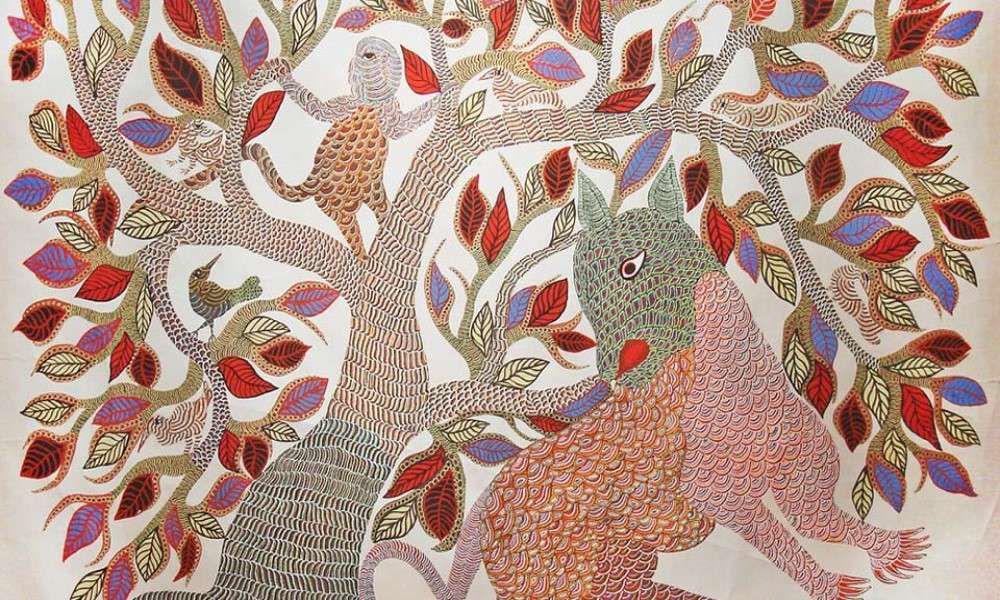Gond Art and Painting: Past, Present and Future
Gond painting is one of many varied art forms that will be a part of the Hands of Grace handicraft exposition at the Isha Yoga Center. In this article, we look at the past, present and future of Gond art. Adventurous readers may like to attend the workshop on Gond art at the exposition!

Gond painting is one of many varied handicraft forms that will be a part of Hands of Grace, a handicraft exposition at the Isha Yoga Center, from February 19 – 27, 2014. In this article, we look at the past, present and future of this traditional form of tribal art. Adventurous readers may like to attend the workshop on Gond art at the exposition!
Craft: Gond Painting
Artisan: Suresh Kumar Dhurve
Place: Madhya Pradesh

The Gonds are among the largest tribes in Central India, numbering about 4 million. Though predominantly centered in Madhya Pradesh, they are present in significant numbers in the states of Madhya Pradesh, Andhra Pradesh, Maharashtra, Chhattisgarh and Odisha. The word “Gond” comes from the Dravidian expression kond, meaning “the green mountain.” The recorded history of the Gond people goes back 1400 years, but considering that they inhabit areas where rock paintings dating to the Mesolithic have been found, their antecedents probably date back even further. Many of the Gonds customs echo that of their Mesolithic forbearers. An obvious example of this is the custom of decorating the walls of their houses, an activity that may originate in cave-dwelling traditions of their ancestors.
Subscribe
The Gonds paint their walls with vibrant depictions of local flora, fauna and gods such as Marahi Devi and Phulvari Devi (Goddess Kali). Traditionally made on festive occasions such as Karwa Chauth, Diwali, Ashtami and Nag Panchmi, Gond painting depicts various celebrations, rituals and man’s relationship with nature. The artists use natural colors derived from charcoal, colored soil, plant sap, leaves, and cow dung. This mystical art form is created by putting together dots and lines. The imaginative use of the line imparts a sense of movement to the still images. The paintings are an offering in worship of nature, and are also a mode of seeking protection and warding off evil.
Today, many talented Gond artists' works including Suresh Kumar Dhurve's can be seen on canvases in art galleries internationally. One of the distinctive elements is the use of signature patterns that are used to infill the larger forms on the canvas. A certain sense of balance and symmetry can be observed in the pattern used, such as spiral forms along with trees, leaves, animals and human figures. Painted in several bright colors, the placement of motifs showcasing village life and the blending of human figures with rituals and nature depict the Gonds inherited skills and creativity. In the eyes of a Gond artist, everything is sacred and intimately connected to nature. Thus, the unique oral narrative tradition of the Gonds is reflected in their paintings as well. The work of Gond artists is rooted in their folk tales and culture, and thus story-telling is a strong element of every painting. However every artist today has a personal style and has developed a specific language within these narratives creating a richness of aesthetic forms and styles.
Suresh Kumar Dhurve’s favorite subject is the tree of life, and he often presents trees almost like a totem pole, erect and still, surrounded by human figures. He features different kinds of birds too, while his signature pattern is fish scales and drops of water. Each painting takes him anywhere from ten hours to three days.
Gond art comes with the belief that a good image brings good luck. This inherent belief led the Gonds to decorate their houses and floors with traditional tattoos and motifs. Today, Gond art products such as Gond painting on wood, painted wooden trays and boxes have become extremely popular globally.
Hearteningly, Gond art hasn’t escaped the eye of the art connoisseurs in the country. The Indian government is making efforts to preserve Gond painting. Other well-wishers have gone a step further, and created the Must Art Gallery– the world's first art gallery dedicated to Gond art. Unlike so many treasures of Indian culture that have slipped through the cracks of time and were lost forever, the future of Gond art looks as vibrant and colorful as the paintings.
For more of Suresh’s paintings visit: Fine art America and Artweb Gallerie
References: http://www.gondtribalart.com/, Handmade in India – An Encyclopedia on Crafts of India.
Editor’s Note: Suresh Kumar Dhurve will be conducting a Gond painting workshop during Hands of Grace. Besides Gond art, workshops on Sanjhi Paper Art, Madhubani Painting, hand-block printing, clay modeling/pottery and traditional flower garland-making will also be conducted.

 Program Finder
Program Finder
